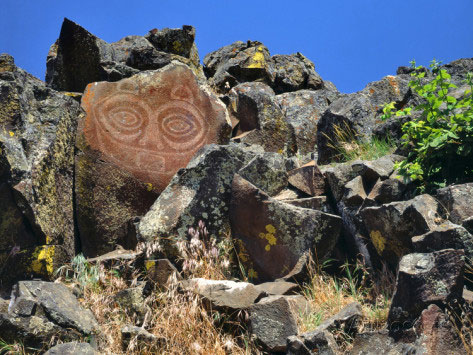Columbia Hills Petroglyphs, Washington

Located on the Washington side of the Columbia River Gorge near The Dalles, Columbia Hills State Park is home to a remarkable collection of Native American rock art. It includes the Temani Pesh-wa Trail, a collection of ancient petroglyphs saved from the rising waters of the Dalles Dam, as well as pictographs including the famous “She Who Watches.” The artworks are sacred to the local Native Americans but also open to the public “for the benefit of all people as a tribute to all living and non-living things.”
For hundreds of years (specific dates are unknown), this area alongside the Columbia River hosted a Native American village, whose inhabitants hunted local game, caught salmon in Celilo Falls, and carved images on the rocks alongside the river. Lewis and Clark stopped here in 1805 during their expedition to the Pacific Ocean, describing the village’s wooden houses in their journals.
The traditional way of life ended here in 1957, when the Dalles Dam was completed by the U.S. Army Corps of Engineers. The dam supplied much-needed power for homes and businesses in the region, but it also flooded the historic village and eliminated Celilo Falls.
The project was strongly opposed by the tribes as well as some environmental groups, resulting in a payment of $23.5 million to compensate for lost tribal fishing rights at Celilo Falls and to fund scientific research into conservation of the salmon runs.
Before the rising waters submerged Petroglyph Canyon (an area upstream of the dam), a small selection of petroglyphs were removed and stored at the Dalles Dam. They remained in storage for nearly 30 years before they were restored and displayed here in 2004.
According to a sign at the site, project was undertaken at the request of the Confederated Tribes and Bands of the Yakama Nation, the Confederated Tribes of the Warm Springs Reservation of Oregon, the Confederated Tribes of the Umatilla Indian Reservation and the Nez Perce Tribe, with the assistance of the U.S. Army Corps of Engineers, the Bonneville Power Administration and Washington State Parks.
Named Temani Pesh-wa (Written on Rock) Trail, the new site was opened to the public in 2004 in what was formerly known as Horsethief Lake State Park. That park combined with Dalles Mountain Ranch to become Columbia Hills State Park in 2003.
The petroglyphs are displayed on their original slabs of rock leaned up against a natural rock formation. Vegetation is slowly growing around the petroglyphs, giving the man-made display an increasingly natural atmosphere. Subjects of the petroglyphs include a variety of local animals, such as elk, bighorn sheep, owls and eagles, as well as some human and geometric figures.
Visitors view the petroglyphs from behind a wooden fence along a paved trail, which has signs containing photographs and explanations of original locations. Accessible only during daylight hours, the petroglyphs are protected by electronic and personal surveillance.
Under even greater protection is the famous pictograph known as Tsagaglalal (She Who Watches), which can only be visited on a guided tour (see below for details). This striking figure, characterized by large staring eyes, is thought by some to represent the death and disease brought by white settlers in the 18th and 19th centuries.
Several other pictographs can be seen on the guided tour as well. Unlike the petroglyphs displayed along the trail, these remarkable works of rock art are in their original positions.
Other Native American artifacts from the area, including a few more petroglyphs, can be seen at the nearby Maryhill Museum of Art and the Columbia Gorge Discovery Center.









